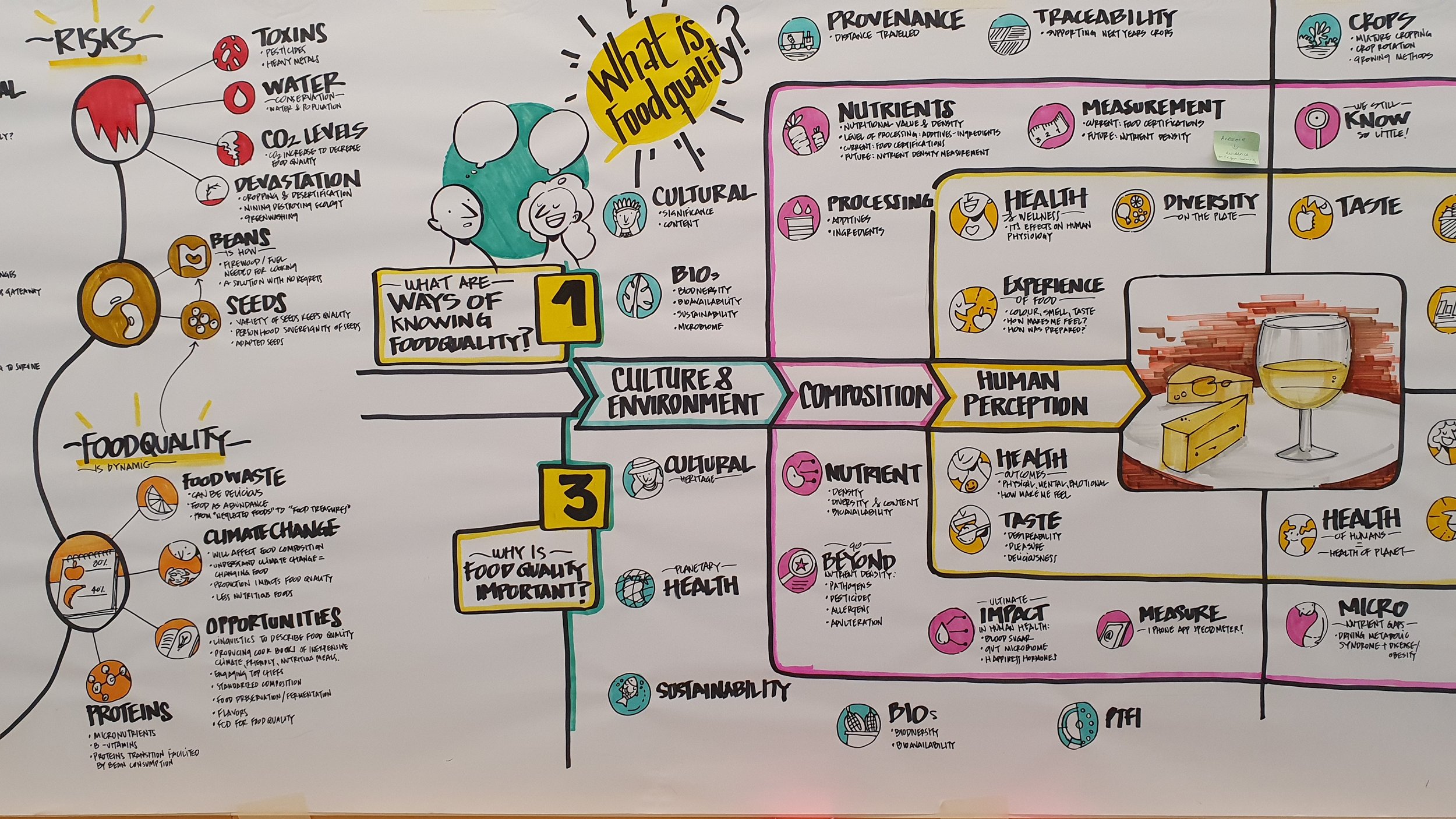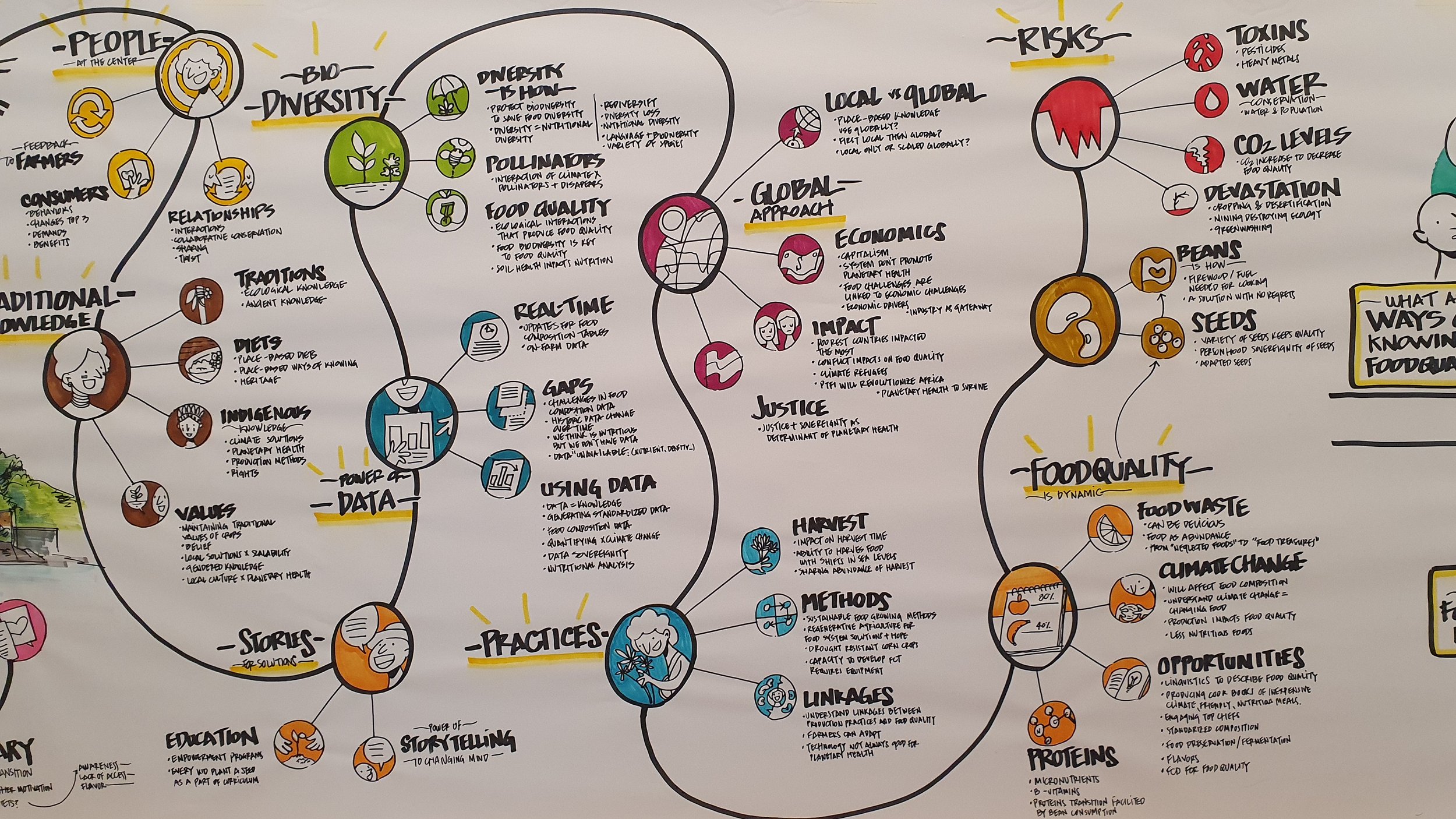CONVENING DESIGN AND FACILITATION
Exploring Food Quality and Human Health through Visual Frameworks
A Week of Visualizing at the Bellagio
Collaborators
Periodic Table of Food Initiative, Empowerdraw
Geography
Bellagio Center: Global
Timeline
1 Week, June 2023
COLLABORATORS
The Periodic Table of Food Initiative (PTFI) is a global project supported by the Rockefeller Foundation, the American Heart Association, and CIAT (International Center for Tropical Agriculture)
Empowerdraw is a creative consultancy specializing in visual facilitation, using graphic recording and illustration to support sensemaking, strategic planning, and decision-making.
Summary
In June 2023, the Periodic Table of Food (PTFI) brought together influential voices from diverse backgrounds, including scientists, researchers, nutritionists, indigenous representatives, advocates, and farmers. We embarked on a journey to define food quality and uncover its connections to climate change and human and planetary health.
Hosted at the Bellagio Center, the event was designed to foster creativity, collaboration, and meaningful interactions. Guided by emergent strategies, design thinking, and visual methodologies, the facilitation process aimed to generate impactful visual frameworks highlighting insights and opportunities identified by attendees.
The event fostered new connections, supported relationship building, and culminated in creating a series of visual frameworks highlighting the importance of food quality and its link to planetary and human health. The event's outputs, captured in visually captivating vignettes and frameworks, aim to support global food systems dialogues, inspire policy-making, and serve as a foundation for advancing food composition data.

Opportunity
This Bellagio convening presented a remarkable opportunity to bring together influential voices from diverse backgrounds. Scientists, researchers, nutritionists, indigenous voices, advocates, and farmers joined forces to explore the intricate connections between food quality and human and planetary health.
As a Food Systems Consultant, my role was to serve as a thought partner and lead facilitator, with a focus on designing avenues that fostered human connection and serendipitous encounters. Collaborating closely with a Visual Facilitator, we leveraged emergent facilitation techniques, design thinking, and visual methodologies to support sensemaking and create impactful visual communication tools.
This event offered a unique opportunity to facilitate new and eye-opening connections, support relationship building, and, ultimately, an avenue to co-create a series of visual frameworks that would underscore the significance of food quality and its connections with planetary and human health.
The challenge: curate and facilitate a three-day event for a diverse group of food system actors eager to explore questions, expand their understanding of food quality, and collaboratively generate visual models capable of capturing curiosity and influencing policymakers and researchers in the field.

Process
Identifying Key Design Elements
We began by defining "guiding atmospheric ingredients" that would shape the overall design of the convening. These elements were crucial in creating an immersive experience for the attendees. We wanted the event to be energetic, encouraging diverse perspectives; dynamic, fostering unplanned activities and the emergence of ideas; and catalytic, with the creation of a powerful visual model that would unlock opportunities and symbolize our time together.
Grounding the Design in Desired Outcomes
We framed the design experience of the event by moving from the micro, “I” to the macro, “we” to the super-macro “the system.”
I - At the individual level (“I”), attendees were prompted to reflect on their personal understanding of food quality and its connection to their work.
We - At the collective level ("We"), we explored the key elements that should inform a visual framework for understanding food quality and its relationship with planetary health, seeking to make it relevant to their work.
System - At the broader system level ("The System"), we delved into the potential impact of composition data on the larger system, exploring ways to operationalize the data gathered by the PTFI team based on the connections highlighted in the visual framework.
During the event, our primary focus was on the collective level ("We"), aiming to co-design a series of visual frameworks that would encapsulate the definition of food quality, its ties to planetary health, and the opportunities for transformative systems change.
Visual Elements to Facilitate Sensemaking
Collaborating closely with a Visual Facilitator, we harnessed the power of visual elements to support sensemaking, generate insights, and facilitate decision-making. Through design thinking methodologies, we developed a range of visual canvases that fostered conversation and decision-making within small groups. Visual recordings of the conversations played a critical role in sensemaking, nurturing curiosity and creativity among the participants. All these visual elements directly contributed to the development of the series of visual frameworks.
To kick off the event, we invited each participant to deliver a "rapid-fire" presentation, introducing themselves and sharing a personal connection to the food quality theme. Many participants accompanied their presentations with short decks incorporating photos and visual elements that enhanced their storytelling. Some attendees even shared food products, inviting participants to become part of their stories and experience these culinary treasures.
Visual elements had the power to elevate personal narratives and served as memorable components that fostered “in the hall” connections between sessions. The picturesque setting of the Bellagio Villa itself became a visual element that inspired conversations and forged connections.
Learning from Local Actors
During the event, we dedicated specific time for attendees to engage with local producers and actors in the nearby, local food system. They had the opportunity to visit regenerative farmers, fisherfolk, as well as learn from wine, grappa, and cheese producers. This firsthand experience and insights from local actors enriched their understanding of food quality, contributing to the theoretical model of the event and informing the output of the final visual frameworks.
Humanness as the Ingredient to Connection
In-person events offer a unique capacity to foster human connections like no other. Attendees brought their personal stories, knowledge, and curiosity, allowing conversations to transcend the technical realm.
Throughout the three-day event, we encouraged participants to form smaller pods and explore a series of questions together. This approach enabled them to bring their perspectives into the discussion, considering food quality not only from a scientific and nutritional perspective but also in the context of culture and human connection. Many attendees shared their personal stories, which served as inspiration for the work they led and prompted us to consider the influence of language, tradition, and storytelling as critical elements.
Project Outputs
The culmination of this convening was a series of visual frameworks that shed light on various aspects:
Ways of understanding food quality and why it matters
The interconnections between food quality, planetary health, and human health
The influence of the environment, agriculture, and culture on food quality
Evaluating and assessing food quality
With the assistance of the Visual Facilitator, a design thinker and phenomenal artist, PTFI captured key insights from facilitated conversations in beautifully crafted story vignettes, visually representing the ideas, questions, and insights that attendees contributed in real-time. These illustrated insights served as inspiration for the final food quality frameworks.

Key Insights
Visualizing insights and curiosities captured from conversations in real-time enhanced the group's ability to process information and establish connections. The finely tuned sensemaking within the group contributed to the co-creation of the Food Quality Visual Frameworks.
At the core, everything is relational. The best outcomes emerge when we create space for people to connect on a personal level, link ideas from various contexts, and synthesize new concepts. The more time we allow for connection and relationship building, the more rich and transformative the experience and outcomes.
Engaging with local producers and actors in the food system allowed attendees to move beyond intellectual knowledge and into experiential knowledge. This integration of experience and intellect influenced the conversations and insights, introducing new factors in the Food Quality Visual Frameworks.
Considering these concepts in isolation is insufficient. Understanding the local system is essential to comprehending the broader system. Attendees from different corners of the world gathered locally to explore global food quality considerations. By creating opportunities for connection, diverse thought, shared learning, and connections from local to global, we fostered a powerful combination that supported the event's outcomes.





